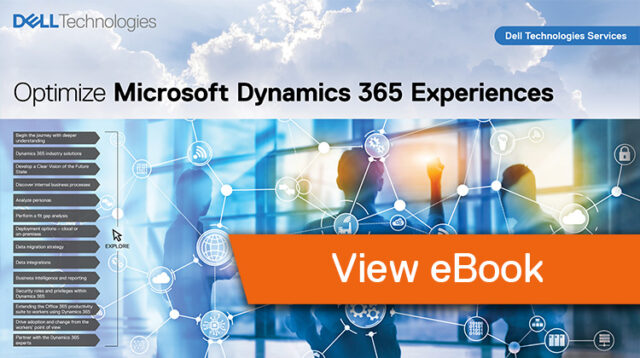Where to begin?
First ask yourself (and your SMEs) what is and isn’t working with your CRM or ERP solution today? How well do you understand your team members day-to-day tasks? All too often current business processes do not necessarily fit into standard out of the box ERP and CRM solutions. The goal of your new Dynamics 365 solution should be to eliminate process inefficiencies, manual entry and duplication of effort, while automating and aggregating data to empower your workforce to make faster and more confident decisions. Understanding your current state is the best place to start.
Our new Microsoft Dynamics 365 eBook provides guidance for your journey to a modern ERP and CRM solution.
Art of the Possible
 Microsoft offers several industry solutions for Dynamics 365. Even if these solutions don’t have everything your organization needs, they’re great accelerators. With Dynamics 365’s extensible framework you can decrease the gaps in your organizations’ processes. Navigating all the possibilities with Dynamics 365, together with the Office 365 ecosystem, requires careful planning and thoughtful considerations to ensure you get the most out of your investment and improve your workers’ experiences.
Microsoft offers several industry solutions for Dynamics 365. Even if these solutions don’t have everything your organization needs, they’re great accelerators. With Dynamics 365’s extensible framework you can decrease the gaps in your organizations’ processes. Navigating all the possibilities with Dynamics 365, together with the Office 365 ecosystem, requires careful planning and thoughtful considerations to ensure you get the most out of your investment and improve your workers’ experiences.
Create the Vision
A clear vision and direction for your future state is critical when planning for a new ERP and CRM deployment. SMEs with the right experience and knowledge are ideal to help architect your new processes and needed technology changes. The goal of defining a future state solution is first to get the right people in the right place doing the right thing (processes) and then provide the tools and technology to maximize their efficiencies.
Analyze Personas
When deploying new business applications, consider both workers and their technology habits to ensure alignment with your overall technology strategy – BYOD, mobility, etc. Every worker focuses on productivity differently, so a crucial step to deploy a successful Dynamics 365 solution is to find out as much as possible about the workforce and how they are working today and group them into personas. “Day in the life” persona reviews can help to reveal successes and challenges workers face on a regular basis and are ideal for pinpointing problem areas your new solution needs to address.
Fit Gap Analysis
Performing a persona analysis and business requirements assessment prepare the organization to identify the key business requirements and future state “must have” and “nice to have” functionality. Conducting a fit/gap analysis will identify which business requirements can be met by “out of the box” Dynamics 365 functionality (known as a “fit”) and which requirements are not met (known as a “gap”). Once all the gaps are known it becomes a matter of answering the following questions:
- Should you change your processes to align with the out-of-the-box features?
- Is the gap important enough to address with the new solution and does it warrant the budget and time to implement?
- Is there a 3rd party solution that integrates with Dynamics to close the gap and is it worth the cost and time?
Data Migration Strategy
The best approach is to build a formal data migration strategy to determine the data types and quantity to be migrated. Reviewing and cleansing data to be migrated is essential for populating your new Dynamics 365 solution. Going through this process, you may find there’s data that doesn’t need to be migrated but does need to be available to your Dynamics 365 solution for lookup, reference or integration.
Security Roles and Privileges
Dynamics 365 has multiple levels of security to ensure access is only granted based on defined roles. It’s highly integrated with Office 365 and uses Azure Active Directory to allow for single sign-on. Access to Dynamics 365 must be specifically granted to AAD users. Security privileges are assigned within the application to define what a worker can and cannot do.
Office 365 Integration
While there has always been integration between Dynamics and the rest of the Microsoft productivity suite, the shared tenant model with Dynamics 365 and Office 365 simplifies this integration. Traditional integrations required connectors, whereas now integrations can be turned on in just a few steps during setup and configuration.
Change from the Workers Point of View
Lack of worker adoption is the single biggest reason why Dynamics 365 ERP and CRM solutions fail. The importance of an adoption and change management program can’t be emphasized enough. It’ll make the difference between reaping the benefits you expect from the new solution or having it fall short of expectations. Approach change from the workers point of view, helps them understand what’s in it for them and why they should care. By taking a persona-centric approach trainers and stakeholders are better equipped to create a more targeted, tailored and effective set of plans for creating awareness, developing communication campaigns, educating workers and building excitement for the new solution.
Need Help Tailoring with Your Dynamics 365 Solution?
At Dell Technologies Consulting Services, we understand the Dynamics 365 industry best practices and the wide array of available choices for its extensible framework. Our Dynamics 365 Practice has deep industry expertise designing and delivering modern ERP and CRM solutions. We can help organizations like yours navigate whether to use the native platform, customize or adopt pre-built add-ons to meet your unique business needs and deliver experiences that help your workforce excel. To learn more, read our perspective Optimize Microsoft Dynamics 365 Experiences.
Looking to get help with your ERP and CRM solution?
Comment below to start the conversation, or contact Dell Technologies Consulting, Microsoft Dynamics 365 experts, to learn how we can help you.


